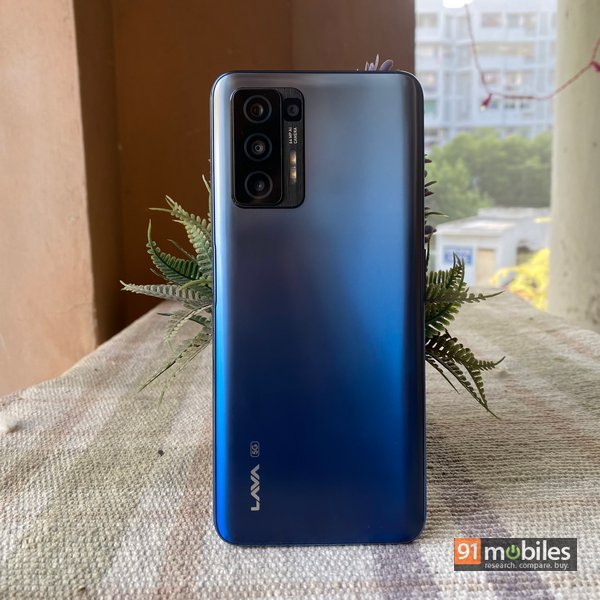Indian smartphone brand Lava has come out with its first 5G phone, which it has marketed as #ProudlyIndian to appeal to our patriotism. On paper, the specs of the Lava Agni 5G look promising for its price tag of Rs 19,999, but can it stand up to the heat from its Chinese counterparts? Let’s find out in this full review of the device.

Verdict
The Agni 5G has the potential for being a good choice for users looking for a smartphone under Rs 20,000, but only if Lava can promise software updates and make improvements in the camera department. That apart, the phone scores high in aspects like performance and battery life, making it worth a closer look.
The lowdown

The Lava Agni 5G gets a polycarbonate unibody design with a dual-tone gradient finish. The back refracts light when looked at from different angles and I love the blue-silver colour combo. In terms of the in-hand feel, the Agni 5G is thicker than most phones in the same price range and also heavy, which is surprising since its battery capacity is par for the course at 5,000mAh. A vertically-arranged quad-camera setup can be seen on the phone’s rear, on top-left, and its protrusion from the chassis is slight but enough to make the device wobble on a flat surface. The fingerprint sensor is integrated with the power button on the side while the volume rocker is on the opposite edge. Finally, the bottom of the phone holds the usual USB C, 3.5mm headphone jack, and a speaker grille. Overall, the design language is good, but it doesn’t stand out like how the Redmi Note 10 Pro Max does in the same price segment. In terms of display, the Agni 5G has a 6.78-inch FHD+ LCD panel with 90Hz refresh rate and a punch hole on the top-centre for the selfie shooter. As a measure of sheer visual quality, the device’s display does offer punchy colours with a saturated look and decent viewing angles. The brightness levels are acceptable enough to work under sunny conditions outdoors. There is WideVine L1 certification for HD content on OTT platforms while the 90Hz refresh rate works well enough on most occasions with a slight stutter here and there.

Talking about the optics, the primary camera on the phone is a 64MP shooter while the supporting cast includes a 5MP ultra-wide, 2MP macro, and 2MP depth sensors. The selfie camera housed in the punch hole up top can click 16MP photos while the video capabilities of the primary sensor include up to 2K@30fps clips. The daylight images from the main camera are above average with a decent amount of detail but sometimes, the shots can look akin to an oil painting. Exposure handling is satisfactory although the dynamic range across the frame is not consistent. The ultra-wide sensor warps the photo at the edges while also having a soft plane of focus. The macro sensor serves little function other than to pad up the camera system, though the depth sensor can help with a decent output as far as portraits are concerned. In low light, the shots lack any clear detailing with a lot of noise being introduced while the AI-enabled Night mode does very little to rectify the shots unless assisted by a ton of external lighting. The camera capability is definitely an area where the Lava Agni 5G could use a lot of improvement.
The headlining act for the device is the MediaTek Dimensity 810 5G chipset which is responsible for the processing capabilities of the device. The Agni 5G is adept at handling processor-heavy tasks such as operating multiple apps simultaneously, opening several Chrome tabs, or switching between apps. With 8GB of RAM and 128GB storage, you are mostly covered in terms of memory requirements. GPU-intensive tasks like PUBG New State and BGMI can be set at medium graphic settings and the game can achieve a stable 45fps for a sustained time period.

Software-wise the Lava Agni 5G runs a skin that is close to stock Android 11. It’s free of bloatware and easy to use. The overall design elements on the icons, quick settings, drop-down menu, and themes do look slightly modified though. The 5G capabilities of the phone can unfortunately not be tested since the necessary telecom infrastructure is not present in the country. The 5,000mAh battery on the device is quite decent in terms of providing a full day of usage with up to 40 percent charge still left in the tank afterwards. Inside the box, there is a 30W fast charger present which tops off the battery in about 90 minutes.
Final verdict

The Lava Agni 5G is a tad bulky, and there could be questions around whether Lava can provide timely software updates. More importantly, the optics on the phone are definitely in need of improvement. Therefore, it would be safe to say that at the same price, you are better off with a POCO, Xiaomi, or Realme device, some of which can offer a more well-rounded experience. That said, the Lava Agni 5G definitely has a few things going for it, including satisfactory performance and a healthy amount of RAM. The battery can last for more than a day, and its software is pretty much stock Android. If these are aspects that appeal to you, the Agni could be worth considering.
Editor’s rating: 3.5 / 5
Pros
- Decent performance
- Good battery life
- Near stock Android
Cons
- Cameras need improvement
- Bulky design
The post Lava Agni 5G review: can it set the affordable segment on fire? first appeared on 91mobiles.com.
via ©91 Mobiles









No comments:
Post a Comment